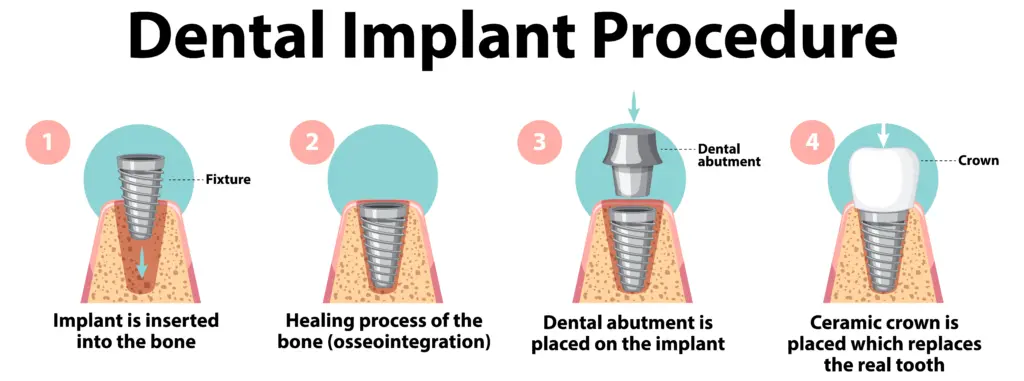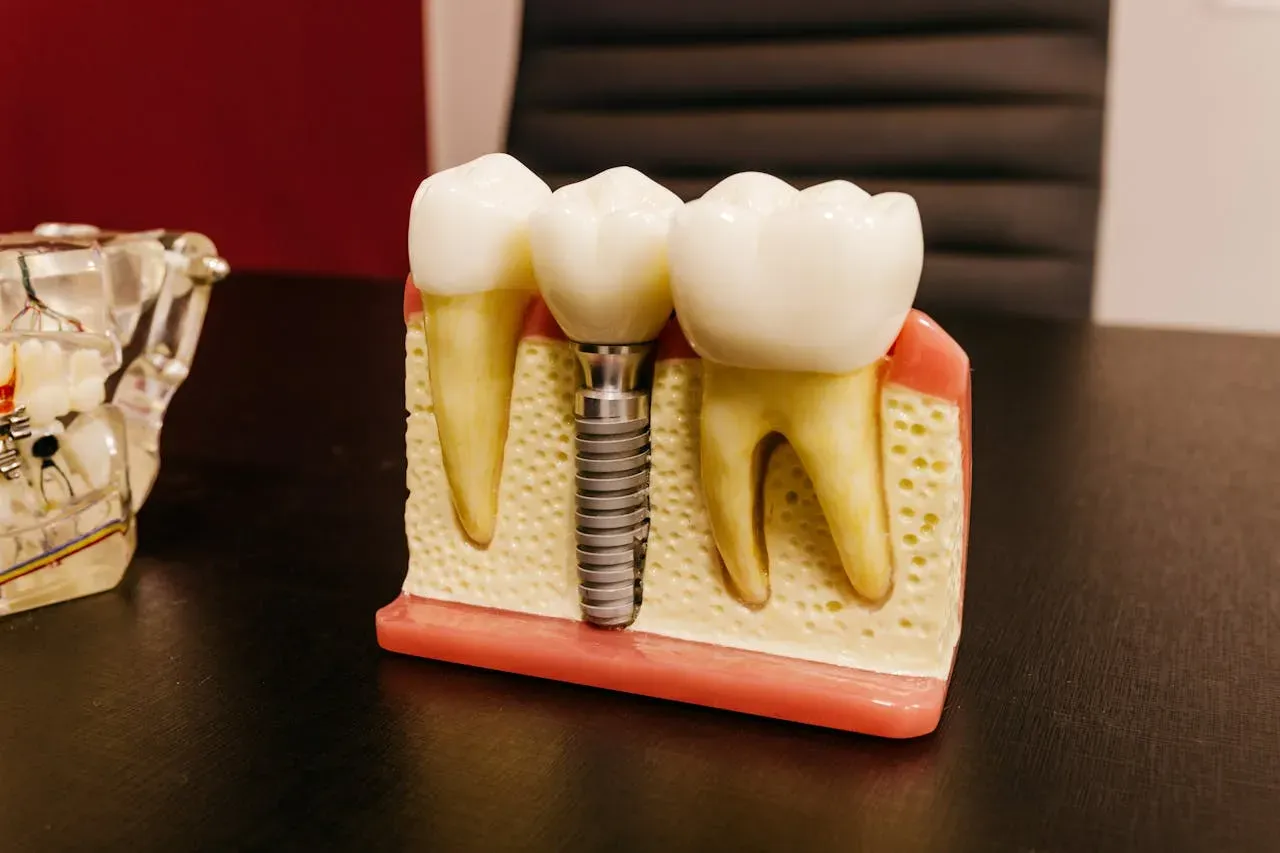When a molar is lost, the impact goes beyond appearance. These back teeth absorb most of the force during chewing, and without them, digestion and tooth alignment can be affected. Replacing a missing molar with an implant is often the most reliable way to restore both strength and comfort, but it requires careful planning.
A molar tooth implant is a surgical procedure that replaces a missing molar with a titanium screw, which is placed into the jawbone to act as a new tooth root. Over time, the bone fuses with the implant through a process called osseointegration, creating a stable foundation. A custom-made crown is then attached, completing the restoration. This creates a durable, functional, and natural-looking replacement that restores chewing power and helps prevent future oral health issues.
What a Molar Tooth Implant Involves
A dental implant for a molar typically follows several key stages:
- Consultation and planning – the dentist assesses bone density, gum health, and surrounding teeth, often using X-rays or 3D scans.
- Implant placement – a titanium screw is surgically inserted into the jawbone under local anaesthetic.
- Healing and osseointegration – over three to six months, the bone bonds with the implant to create a secure base.
- Abutment placement – a small connector is fixed to the implant once stable.
- Crown placement – the final step, where a custom crown is attached to restore full function.
Most patients are able to return to normal activities within a few days, although the full healing period takes longer. For more details, see this guide on what to expect during the dental implant process.
Pre-treatment Assessments
Before beginning, the dentist will check:
- Jawbone quality – strong bone is needed to hold the implant securely.
- Gum health – healthy gums are essential to avoid infection.
- Medical history – conditions like diabetes or medications affecting bone healing may influence treatment.
This planning stage ensures the implant is not only successful but also safe for long-term use.
Benefits of Choosing a Molar Tooth Implant
Choosing a molar implant can offer several advantages compared to leaving the gap or using other replacements:
- Restores chewing efficiency – molars are critical for grinding food, and implants allow proper digestion.
- Prevents bone loss – without stimulation from a tooth root, the jawbone can deteriorate. Implants help maintain density.
- Keeps teeth aligned – missing molars may cause neighbouring teeth to drift. An implant prevents unwanted movement.
- Durable and long-lasting – with good care, implants can last for decades.
- Natural appearance and feel – implants are designed to look, feel, and function like natural teeth.
According to Cambridge University Hospitals NHS Foundation Trust, patients can expect the overall treatment to take several months, with additional time required if bone grafting is needed.
You can also explore the benefits of dental implants for further insight.
Recovery and Healing Timeline for Molar Implants
The healing journey usually follows this pattern:
- First two days – swelling, tenderness and bruising are common, so soft foods are advised.
- One to two weeks – stitches are removed if present, with most initial healing complete.
- Three to six months – osseointegration strengthens the implant’s foundation.
- Final stage – once stable, the crown is fitted.
While the gum tissue heals relatively quickly, the deeper bone healing takes several months. Good oral hygiene and following aftercare advice make a significant difference to recovery.
Managing Discomfort After Surgery
Patients may experience:
- Mild pain or soreness, managed with over-the-counter pain relief.
- Temporary swelling or bruising near the site.
- Difficulty chewing hard foods during the first week.
These symptoms generally resolve within 7-10 days. Returning for regular follow-up appointments ensures the implant is healing correctly.
For practical advice during recovery, see this guide on how dental implants work.
Costs and Considerations Before a Molar Tooth Implant
The cost of a single molar implant usually includes the implant, abutment, and crown, with private treatment ranging between £1,800 and £3,000.
Key considerations before treatment include:
- Bone density – a graft or sinus lift may be necessary if significant loss has occurred.
- Anaesthesia – commonly performed under local anaesthetic, but sedation or general anaesthetic may be available.
- Oral hygiene commitment – daily brushing, flossing, and regular check-ups are vital for long-term success.
- Lifestyle choices – smoking, poor diet, or uncontrolled health conditions can lower the success rate.
At Birchgrove Dental, patients receive tailored advice at the consultation stage, ensuring treatment plans are both effective and suited to individual needs. It may also be helpful to compare dental implants vs dentures before making a decision.
Risks and Possible Complications
When carefully planned, molar tooth implants are highly reliable. Cambridge University Hospitals report long-term success rates between 80 and 95 per cent, depending on gum health and overall wellbeing.
Potential risks include:
- Peri‑implantitis – a gum disease that affects tissues around the implant.
- Mechanical stress – molars take on strong chewing forces, increasing the risk of strain.
- Failure to integrate – rare, but occurs if the implant does not bond with the bone.
- Health and lifestyle factors – smoking and uncontrolled diabetes can reduce success rates.
Fortunately, with good planning and ongoing oral care, these risks can be minimised.
Looking After a Molar Tooth Implant
Daily care is crucial for long-term success. The Leeds Teaching Hospitals NHS Trust advises that patients must commit to long-term oral care, including brushing and cleaning between the teeth, alongside regular check-ups.
Care recommendations include:
- Brushing twice daily with fluoride toothpaste.
- Using floss or interdental brushes to clean around the implant.
- Attending professional check-ups every 6 to 12 months.
Practical guidance is also available in these tips for healthier teeth and gums, which apply to implant care too.
Long-Term Maintenance
Implants can last decades, but this depends on:
- Consistent daily cleaning routines.
- Attending scheduled dentist and hygienist appointments.
- Avoiding harmful habits like teeth grinding or smoking.
Patients who follow these steps often keep their implants for life.
Alternatives to a Molar Implant
If a molar implant is not possible or not preferred, alternatives include:
- Dental bridges – these rely on neighbouring teeth for support. For context, here is a guide on understanding and choosing dental crowns, often used with bridges.
- Removable partial dentures – less invasive, but less stable.
- Leaving the gap – in some cases, especially if only a second molar is missing, this may be acceptable.
Dentists can advise which option best suits oral health, budget, and long-term goals.
Final Thoughts
A molar tooth implant is one of the most effective ways to restore strength and chewing function after losing a back tooth. It prevents bone loss, protects alignment, and can last for decades with the right care. While the process can take several months and may require additional procedures, the long-term results are excellent for patients who maintain good oral hygiene.
For patients considering their options, Birchgrove Dental provides personalised implant assessments and treatment planning tailored to individual needs. If you are missing a molar and want to restore both comfort and function, booking a consultation is the best way to take the first step toward a lasting solution.






